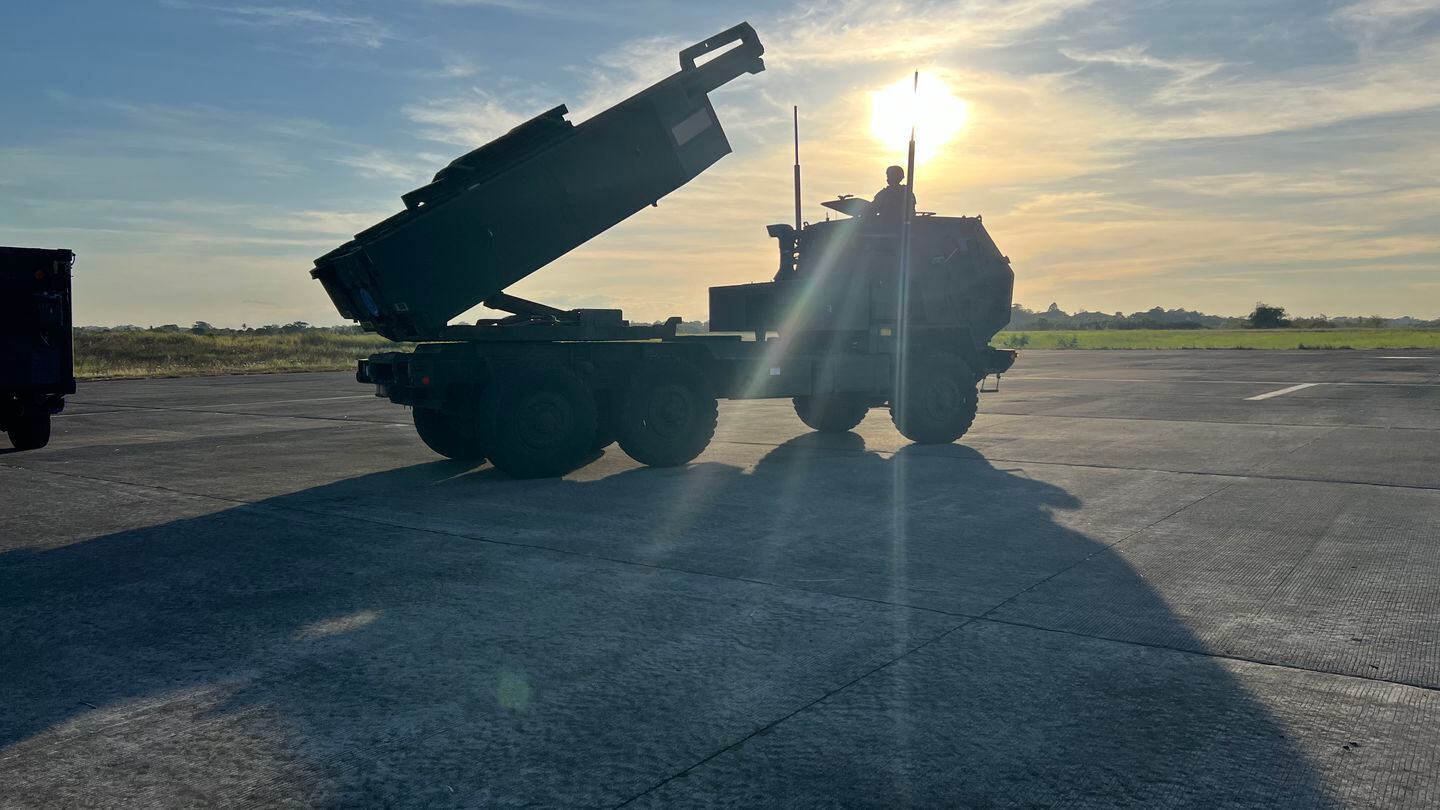LA-LO, Philippines — The High Mobility Artillery Rocket System has gained international attention in recent years, particularly in the war in Ukraine, but a U.S. Army unit challenged the system’s ability to rapidly deploy in a drastically different Pacific island environment this month during the bilateral training exercise known as Balikatan in the Philippines.
HIMARS made a trip down to the southwestern island of Palawan and up to northern Luzon, hitching rides on C-130s and being whisked from ship to beach using U.S. Marine Corps amphibious hovercraft called Landing Craft Air Cushion, or LCACs. These vessels are large enough to carry an M1 Abrams tank.
The Lockheed Martin-manufactured HIMARS is a truck-mounted, mobile rocket launcher that can carry six missiles at a time. Lockheed has seen a large increase in HIMARS orders from a wide variety of countries in Europe but was also recently slated to provide a few to Indo-Pacific nations, including Taiwan.
While this is not the first time HIMARS was used at the annual training exercise in the Philippines, the 5th Battalion, 3rd Field Artillery Regiment, Long Range Fires Battalion of the 1st Multidomain Task Force tried to demonstrate how it can be transported and quickly deployed in a plethora of different ways, including via non-Army assets, Capt. Garrett Kohnke, battery commander of Alpha Battery, told Defense News at La-Lo Airport.
During the exercise the Army and its partners demonstrated two HIMARS Rapid Infiltration (HIRAIN) operations.
On May 1, the Army hauled two HIMARS aboard a semi-truck from Fort Magsaysay located in central Luzon to an airfield in Subic Bay on the southwestern side of the Philippines largest island. The HIMARS launchers were then loaded into a U.S. Air Force C-130 transport aircraft and flown roughly 700 kilometers to the San Vincente airfield on Palawan island.
The Army then took HIMARS on a tactical road march to San Vincente beach and loaded the systems onto LCACS, which then drove into the ocean to the U.S. Navy’s USS Somerset LPD-25, an amphibious transport dock, which then traversed the western coast south to Rizal.
The LCACs delivered HIMARS ashore at the beach for a live-fire exercise that included other assets such as 105mm howitzers from the Philippine Armed Forces.
Following the live-fire exercise, the HIMARS systems took a reverse trip back to Subic Bay.

The entire process took 72 hours, according to Kohnke. However, it takes just 30 minutes to load a HIMARS into a C-130 and 10 minutes from rolling off the aircraft to be ready to fire, Kohnke said.
Two days later, the battery prepared to load the two HIMARS systems to fly them via C-130 to La-Lo, located in north-central Luzon not far from the shore. Plans had to be adjusted when one C-130 experienced a problem requiring maintenance and so the Army took just one HIMARS up north from Subic Bay.
At La-Lo, a commercial airport shut down for military operations during Balikatan, the HIMARS system conducted a series of simulated live-fires, receiving fire mission commands from the All-Domain Operations Center, part of the MDTF, set up in the Philippines at a base near Manila.
Then the battery conducted another tactical road march on May 7 from La-Lo to Port Irene, a distance of 40 kilometers.
The purpose of the road march was to prove HIMARS could make it through to a northern port using challenging island infrastructure. Roads in many cases are narrow. Village storefronts and homes along the road are built just inches from where vehicles such as “jeepneys” – made from jeeps left behind by the U.S. military after World War II – and “trisikads” – motorbike taxis – zip through while weaving and dodging each other in intense tropical heat.
The HIMARS went along with two Army Humvees and a Marine Corps Joint Light Tactical Vehicle as well as a Philippines Armed Forces escort in an SUV.
The trip was without incident and took an hour and a half, Kohnke reported as his unit line-hauled HIMARS on a 10-hour road trip back to Fort Magsaysay.
HIMARS can travel roughly 260 miles on one tank of fuel, which is helpful when the system needs to shoot and move quickly well out of the way to avoid enemy detection after firing.

The system has participated in a previous iteration of Balikatan. Last year it played a part in a combined, joint live-fire exercise where participants tried to sink a ship off the coast at a training facility north of Subic Bay.
HIMARS’ rockets missed the ship at the time. The service identified challenges with targeting because the munitions were not able to easily account for drift. Kohnke said drifting at sea is a complex problem because it can take roughly 8 minutes to lock in a target and fire. Ships can move 30 to 40 meters in that time, he explained.
The Mid-Range Capability (MRC) missile tested during Balikatan this year, though not in a live-fire exercise, would better address the challenge of hitting ships at sea, Kohnke said. On the horizon is also the Precision Strike Munition, which could feature ship-killing capability at a later time. The first set of PrSM equipment was delivered to the Army late last year.
Using HIMARS more extensively at Balikatan this year allowed the Philippine Armed Forces to get a closer look at the system as it assesses its own modernization needs, which includes a rocket system like HIMARS.
The southern Pacific is beginning to see more HIMARS customers. Singapore is already a HIMARS user. Australia is also slated to buy 20 HIMARS systems and Taiwan was also cleared by the U.S. State Department to buy 11 HIMARS in late 2020.
from Defense News https://ift.tt/7iPySWZ
via IFTTT

Post a Comment